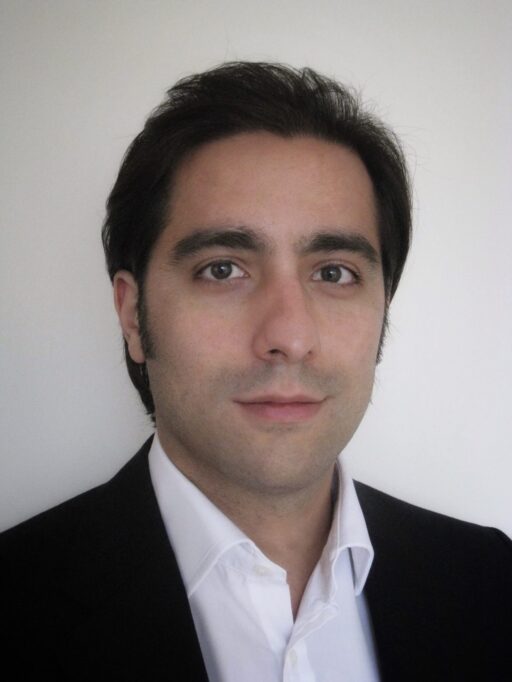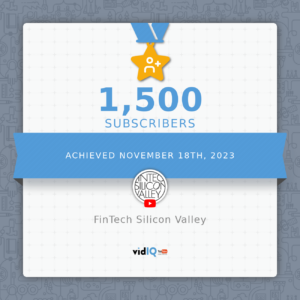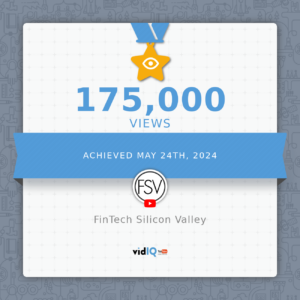
Kamyar Naficy is the Founder and Principal of KNECTCOMMS, a marketing and communications consultancy to the finance, technology and fintech sectors. He previously worked in senior marketing and communications roles at JP Morgan, London Stock Exchange Group and UniCredit. He holds a BA from the London School of Economics and an MPhil (Masters) in Management Studies from Cambridge University.
Kamyar Naficy is the Founder and Principal of KNECTCOMMS, a marketing and communications consultancy to the finance, technology and fintech sectors. He previously worked in senior marketing and communications roles at JP Morgan, London Stock Exchange Group and UniCredit. He holds a BA from the London School of Economics and an MPhil (Masters) in Management Studies from Cambridge University.

Transcription
Pemo: Welcome Kam, thanks so much for joining us today. I’m really fascinated by your experience and background and your expertise in marketing, particularly obviously to the FinTech sector. And I was wondering if you could talk a little bit about your overview of it all?
Kamyar: Yes, sure. Well, thanks Pemo. Thanks for having me. It’s great to be here. I’m the founder, as you said, of a communications consultancy that’s dedicated to the finance and FinTech sector, KNECTCOMMS. I’m based in London and we operate globally. Most of our clients are either incumbent businesses in financial services, so for example investment banking, capital markets, asset management firms, but also FinTech new entrants, so companies disrupting various aspects of these markets with new and exciting ways of doing business. So we kind of see both sides of the equation. And very much what I see is both competition and collaboration between big banks, big tech and FinTech, so it is an interesting space in that regard.
Pemo: Well, I did spend a couple of years in London before I went to Silicon Valley so it’s quite a few years ago, but obviously London was much more ahead, which I was surprised by. I’ve been following Bitcoin since I had a business in Ireland in 2008 and it was much slower in the US when I got there in Silicon Valley. So obviously you guys have had a longer overview of the FinTech market, do you want to talk a little bit about that? What you’ve seen over the years?
Kamyar: Yeah, sure. That’s an interesting point, Pemo. I mean obviously, we’re seeing the digitalization of financial products and markets everywhere around the world. I think the industry now is facing very much once in a generation societal and market disruptions, and that’s, amongst other things, blurring the lines between traditional finance and FinTechs. As I mentioned, a lot of competition and collaboration and the evolution’s been interesting. To your point, some of the activity now in Europe has been quite well established, especially in London. There’s a number of different FinTech hubs obviously in Europe. I mean, London is a leading hub. And to your point about it being a little bit ahead of the curve historically, I think it has a lot to do with the fact that London has a position as an established global financial center. It’s obviously been around for a long time as a financial center and obviously Silicon Valley is a bit different.
Pemo: Yes.
Kamyar: And it’s an interesting blend of obviously historical, deeply established finance talent, but also tech talent and STEM talent as well.
Pemo: And in those days when I was in London, there wasn’t a lot of tech talent or well, particularly women tech talent. And I was pitching for venture and it was like being in a wasteland really. It was a long time ago and I’m really encouraged to see so much happening now in the UK, but also in Europe, so that’s fantastic.
Would you like to talk a little bit about the differences, how you guys approach the markets, the financial markets, both in Europe, or actually on that point, what has the ramifications of Brexit been for you guys?
Kamyar: Yeah. It’s been interesting. I mean, I think that we live in interesting times to say the least, but in some ways, in terms of the big mega trends, it feels a little bit forgotten about to some extent because you had Brexit and, of course, you’ve had the COVID-19 pandemic. There’s been lots of these negative or at least disruptive things going on recently. I talked a bit about, at least in Europe, London, where I’m based, being probably the premiere FinTech hub and it has a very strong leadership position compared to other European FinTech centers, but that’s not to be taken for granted. There are threats and obviously one of those threats are the negative implications, or at least negative perceptions, of Brexit in the financial markets, in particular losing the right to passport with the EU markets. In other words, being able to just work seamlessly with European markets, which we’re not able to do any longer, so that’s a real threat.
I think the other threat to London as a big center is just a growing competition from rival jurisdictions. There are quite a few of those rival jurisdictions beyond London, across Europe.
Pemo: So interesting. Thanks for that feedback. What I was going to ask was, can you talk a little bit about the differences in marketing in Europe now, the UK and the US and Asia? Asia also was a booming thriving FinTech market much before Silicon Valley.
Kamyar: Sure. Absolutely. I’m a little bit less familiar with Asia, but certainly I’ve worked extensively in Europe and the US. There are some interesting differences between US and European marketing, communications and community building in FinTech, which ultimately reflect the wider differences in how FinTechs and techs are managed in the US versus Europe. For example, I think in Europe there’s a bit more of a, I mean it’s changing, but it’s a bit more of a revenue-first, rather than growth-first, approach. In the US, startups traditionally have this big reliance on VC funding and heavy marketing budgets and a focus on growth at all costs and obtaining as many users as possible and you move fast and break things and all that kind of stuff.
Then there’s obviously, at least historically certainly, more accessible funding options than other parts of the world. So there’s less of, I mean, this is not best practice of course, but there’s less of a focus on establishing steady cashflow until a bit later on compared to Europe where there are comparatively fewer later stage funding opportunities so businesses have to get very revenue oriented, otherwise they just can’t survive. The upside of this, I think, is European founders have an opportunity to be more autonomous, they have less equity dilution. And then by generating revenue early on, that’s obviously the best proof that there’s an actual product market fit for their business. I’d also just say that there’s also more of what I would call a sequential go-to-market strategy in Europe versus the US, just because it can be slower to grow in Europe because of all the diversity of all the different European markets. There’s so much localization. I mean, these are 20 plus different states and different jurisdictions.
You have to translate all your products into several languages or you have to, if you’re doing media, it’s obviously not just English speaking media like there is in the US, it’s many different kinds of media. You have to build partnerships in different countries. And that just means it has to be more of a sequential go-to-market approach, which again can have an upside because it can get firms or businesses more focused on achieving product market fit as a business in their own domestic market before expanding to other countries. So all these differences then start to feed through into how tech companies and FinTech companies market and communicate themselves.
Pemo: And now the other thing I noticed in Silicon Valley was that there’s a big difference in the finance markets in New York compared to Silicon Valley. And obviously that market in New York is older, like London. What’s your perspective on that, on the New York financial market and FinTech there?
Kamyar: Yeah. I mean, it’s obviously a very strong market. It’s a strong public market there, there’s strong private capital. I think in some ways it’s more similar to London than it is to Silicon Valley because you have the deeply established financial business there, as well as VC funding, which you also see in London, but it’s just obviously on a larger scale in New York.
Pemo: One of the bonuses of the US is they have their own massive market. And obviously the downfall, as you’ve just pointed out, is that there is a strong focus on and reliance on venture capital. And there are pitfalls to that because there’s a lot of startups that die, maybe too early for the market, forerunners of a trend that comes later. But obviously in Europe, you have, as you said, you have to cater to so many jurisdictions or countries, and I’m sure there’s a bonus to that in the sense of building a strong company and a sense of more globalization than possibly there is in the US. That’s just a question. What’s your perspective on that?
Kamyar: Yeah, it’s a really interesting area. I mean, I think if you look at globalization and some of the longer term economic and demographic trends, you can see all the trends moving in the direction of, actually, Africa ultimately and South Asia. And I think that Europe, with its many different cultures in some ways, and different countries in some ways, is a bit more linked to the wider demographic piece. I think if you think about founders and investors and businesses looking ahead ten years, they’re likely to be looking a lot towards, as I said, Africa and South Asia rather than the kind of focus we have now, which is obviously US, Western Europe, China, Southeast Asia. That’s a little bit different, whereas the US is obviously a huge market, and there’s so much diversity within the US, but it feels like it’s a bit of a world apart from the rest of the world in that sense.
Pemo: Yeah. And obviously the interesting thing about Africa particularly, is that people basically are unbanked. A lot of people unbanked and a lot of great innovation comes out of that because people have to survive. That being right on the rubber on the road, I guess, definitely some incredible creative opportunities. And I’m noticing a lot of FinTech companies in Africa being funded in Silicon Valley now, so that’s really a big leap that wasn’t happening a while back.
Kamyar: Yeah, that makes sense. And I think if you look at big FinTech centers beyond London in the rest of the EMEA region, so Europe, Middle East and Africa, some of the most interesting developments are in Africa. For example, obviously Nigeria is a big hitter. Lagos and Nigeria is one of the biggest African FinTech hubs. There’s a real boom there driven by rising adoption of financial services, relatively young population, digital natives. You have nearly half of the population, 200 million people population of Nigeria, nearly half of that population have bank accounts, but two thirds of adults, I think, have mobile phones. To your point, they’re really interested in a lot of these mobile services or electronic money transfers as well as savings and investment products. I think that’s a really positive story in Africa.
And the other big hub in Africa, I would single out, is Kigali in Rwanda, which is obviously very different to Nigeria in terms of population and size of the economy. But Rwanda’s made some significant inroads in promoting FinTech and, in fact, its wider economy which is transforming a lot. It’s often called the Singapore of Africa. You’re seeing them implement a number of regulatory and industry efforts to promote FinTech, including innovation communities created by the government and the private sector and indeed a sandbox regulatory framework for FinTech. So that’s also very interesting.
Pemo: And of course, we have to talk about crypto and blockchain. I was wondering what your perspectives are on that, or your overview, because obviously you’re in an incredible seat as far as the whole global situation goes?
Kamyar: Yeah, I think that whole wave is really interesting. I mean, if you think about it in terms of web 3.0 and crypto and NFTs and defi and DAOs and all this kind of stuff, I mean the whole move to decentralized finance is really interesting. And I think there’s so many different elements to unpack, but as a marketer and a communicator, if I look at it from that angle, I think it’s, if you think about cryptos being essentially a system that’s decentralized, there’s no sort of intermediaries, it changes the way you market and communicate. It’s arguably less about, you know historically in B2B finance, it’s all about building credibility and confidence in people, which obviously actually, ironically, is a big issue obviously of crypto, but it was about doing that with certain intermediaries. But now I think with decentralized finance, if those intermediaries are being removed, it changes the whole way you market and communicate, so you do it through communities more for example, than you did before. So it just changes the shape of things.
Pemo: Got it. And what’s so interesting also is the froth that seems to have happened, excuse my adjective, particularly since the COVID lockdown started in 2020. What’s your understanding of that? Why has this all happened? It does seem to be settling with the crypto prices dropping and not being so speculative because I’ve always seen Bitcoin as a store of value, but of course it’s been more of a gamble in the last few years. What’s your perspective on this whole big sea change that’s happened while the crisis has been going on?
Kamyar: I think it’s a complex question. I think it’s linked to some of the wider societal changes I alluded to at the beginning and people, the confidence or faith people have, or don’t have. Decentralized systems, and to your point, looking for an alternative store of value, which is obviously a challenge to crypto given how volatile the price is, I guess is the other.
There’s almost like a checklist of currencies to look at. The means of exchange part and the unit of account. It’s hard to use it as unit of account as well, obviously given the fluctuations, but it’s just a space I think we have to watch to see. I think the other part of it is regulation to see how that pans out in the EU and in the US and Asia.
Pemo: And how’s that looking in the UK? I don’t hear much about that. Obviously I’m more focused on the US regulation with the SEC but how’s that looking? Are the financial establishments feeling threatened or are they taking it onboard, the whole crypto Bitcoin?
Kamyar: Yeah, I think it’s just moved very fast in the last year or so. I think there was a time where the big incumbent financial institutions were very resistant or very skeptical, but they’ve all changed. I think the last year or so, even the last few months, they’re all making moves towards crypto and also just the wider space including web 3.0, generally. The metaverse, I saw that JP Morgan became the first bank to establish a presence in the metaverse. It just feels like it’s all evolving very fast.
Pemo: Right? Yeah. It’s accelerated a lot of things. Correct?
Kamyar: Absolutely.
Pemo: I guess peoples’ focus has been different with all the lockdowns and the stringent conditions that people have lived under for so long. I guess it’s not surprising that other stuff would happen.
My last question, I’m sorry to take so long, but you’re very interesting with this global perspective. What’s your thoughts about the NFT craze? It seems millions can be made and millions can be stolen from my viewpoint.
Kamyar: Well, that’s a great question. I’m by no means an expert on NFTs, I just think it’s really interesting, especially how it’s playing out in the art world. Because obviously London’s a big center for the art industry, but I think it just remains to be seen. I think I really do see it as part of that kind of wider decentralized finance and it just poses questions, I think for again, for marketers and communicators and for how they… If you’re representing an NFT business, or any kind of web 3.0 business, how do you explain that to stakeholders? How do you make a strong case for it? How do you make it believable, credible. I think communications will play an important role in that transition.
Pemo: I agree. And obviously it’s the interface between innovation and more established society and community. Fabulous talking to you Kam. You’ve enlightened me quite a bit and I really appreciate it. And I’m sure my listeners will really enjoy this conversation. Thank you so much.
Kamyar: Sure. Thanks, Pemo. Thanks for having me. It was great chatting to you.
Pemo: Okay.

















